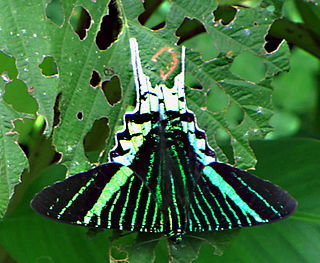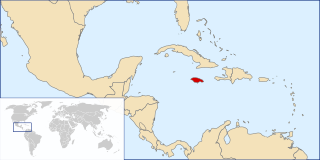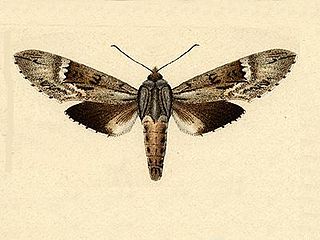
The Uraniidae are a family of moths containing four subfamilies, 90 genera, and roughly 700 species. The family is distributed throughout the tropics of the Americas, Africa and Indo-Australia. Some of the tropical species are known for their bright, butterfly-like colors and are called sunset moths. Such moths are apparently toxic and the bright colors are a warning to predators.

Chrysiridia rhipheus, the Madagascan sunset moth, is a species of day-flying moth of the family Uraniidae. It is considered one of the most impressive and appealing-looking lepidopterans. Famous worldwide, it is featured in most coffee table books on Lepidoptera and is much sought after by collectors, though many older sources misspell the species name as "ripheus". The colours originate from optical interference in the iridescent parts of the wings, while the black parts are pigmented. Adults have a wingspan of 7–9 cm (2.8–3.5 in).

The Uraniinae or uraniine moths are a subfamily of moths in the family Uraniidae. It contains seven genera that occur in the tropics of the world.
Phyllonycteris is a genus of bat in the family Phyllostomidae. It contains the following species:

The Cuban flower bat, also called Poey's flower bat, is a species of bat in the family Phyllostomidae. It is found on the Caribbean islands of Cuba and Hispaniola.

Urania sloanus, or Sloane's urania, was a species of moth of the family Uraniidae endemic to Jamaica. It was last reported in 1894 or 1895, but possibly survived until at least 1908. The species was first described by Pieter Cramer in 1779.

Oenosandra is a monotypic moth genus in the family Oenosandridae. Its only species, Oenosandra boisduvalii, or Boisduval's autumn moth, is found in the southern half of Australia, including Tasmania. Both the genus and species were first described by Edward Newman in 1856.
Aetobatus poeyi is an extinct species of aetobatid eagle ray from Cuba.

Urania leilus, the green-banded urania, is a day-flying moth of the family Uraniidae. The species was first described by Carl Linnaeus in his 1758 10th edition of Systema Naturae. It is found in tropical South America east of the Andes, especially in the Amazon rainforest. Its range includes Suriname, Guyana, French Guiana, eastern Colombia, Venezuela, eastern Ecuador, Brazil, northern Bolivia, eastern Peru, as well as the island of Trinidad. It has been recorded as a vagrant to the central and northern Lesser Antilles, such as St. Kitts, Barbados and Dominica. Their preferred habitat consists of riverbanks, in primary and secondary rainforest, at elevations between sea level and about 800 m (2,600 ft).
Dactyloscopus poeyi, the shortchin stargazer, is a species of sand stargazer native to the coasts of the Bahamas, the Antilles and the Caribbean coast of Central and South America from Belize to Venezuela. It can be found on sandy substrates at depths of from 0 to 9 metres. It can reach a maximum length of 5.8 centimetres (2.3 in) SL. The specific name honours the Cuban ichthyologist Felipe Poey (1799-1891).

Nannoparce poeyi is a moth of the family Sphingidae. It is known from Mexico, Cuba, Jamaica and the Dominican Republic.

Urania fulgens, the urania swallowtail moth or green page moth, is a day-flying moth of the family Uraniidae. The species was first described by Francis Walker in 1854. It is found from Veracruz, Mexico, through Central America to northwestern South America. It is highly migratory and has been recorded as a vagrant to the US state of Texas.

Euscirrhopterus poeyi, the pullback moth, is a moth of the family Noctuidae. The species was first described by Augustus Radcliffe Grote in 1866. It is found from southern Florida and Mexico, through Central America to Brazil. It is also found in the Caribbean, including Cuba.
William Warren was an English entomologist who specialised in Lepidoptera.

Urania is a genus of colorful, dayflying moths in the family Uraniidae, native to warmer parts of the Americas. Their larvae feed on Omphalea.

Urania boisduvalii is a day-flying moth of the family Uraniidae. It was first described by Félix Édouard Guérin-Méneville in 1829. A genetic analysis of Urania moths gave rise to a phylogenetic tree which places U. boisduvalii as sister to the in-group that includes U. fulgens spp. poeyi, U. fulgens, U. sloanus, U. sloanus, U. leilus and U. leilus spp. brasiliensis.

Urania brasiliensis is a day-flying moth of the family Uraniidae first described by William John Swainson in 1833.

The blackear wrasse is a species of wrasse, a type of fish in the family Labridae, from the warmer waters of the western Atlantic Ocean.
Pempheris poeyi, the curved sweeper and shortfin sweeper, is a species of marine ray-finned fish, a sweeper in the family Pempheridae from the western Atlantic Ocean.













